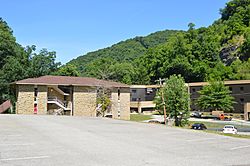Pippa Passes, Kentucky facts for kids
Quick facts for kids
Pippa Passes, Kentucky
|
|
|---|---|

Buildings on the Alice Lloyd campus
|
|
| Nickname(s):
Caney, Caney Creek
|
|

Location in Knott County, Kentucky
|
|
| Country | United States |
| State | Kentucky |
| County | Knott |
| Incorporated | 1983 |
| Named for | a Robert Browning poem |
| Area | |
| • Total | 0.45 sq mi (1.15 km2) |
| • Land | 0.45 sq mi (1.15 km2) |
| • Water | 0.00 sq mi (0.00 km2) |
| Elevation | 991 ft (302 m) |
| Population
(2020)
|
|
| • Total | 468 |
| • Density | 1,049.33/sq mi (405.36/km2) |
| Time zone | UTC-5 (Eastern (EST)) |
| • Summer (DST) | UTC-4 (EDT) |
| ZIP code |
41844
|
| Area code(s) | 606 |
| FIPS code | 21-61374 |
| GNIS feature ID | 0500757 |
Pippa Passes is a small city in Knott County, Kentucky, in the eastern part of Kentucky, United States. It is located along a stream called Caney Fork. The city's official name honors people who helped Alice Lloyd College. However, many local people still call the community "Caney" or "Caney Creek." In 2020, about 468 people lived there. This small city is in the Appalachia region, which is known for its mountains and history of coal mining.
Contents
History of Pippa Passes
Before 1916, this area was known as "Caney" or "Caney Creek." That year, a woman named Alice Lloyd came from Boston, Massachusetts. She worked hard to get money to build a local post office. She also helped start Caney Creek Junior College. The post office opened in 1917, and the college in 1923.
How Pippa Passes Got Its Name
The name "Pippa Passes" came from a gift. The Browning Society gave money to the community. This society was named after Robert Browning, a famous poet. He wrote a play called Pippa Passes. In this play, he wrote the famous line, "God's in His heaven, all's right with the world." Because of this gift, the post office was named after the play. The U.S. Postal Service officially called the place "Pippapass" until 1955.
City Incorporation
The community of Pippa Passes became an official city on July 1, 1983. This happened when the state assembly approved it. When a place is "incorporated," it means it has its own local government. This government can make decisions for the city.
Geography and Location
Pippa Passes is located in eastern Knott County. It sits in the valley of the Caney Fork. The city's exact location is 37°20′5″N 82°52′32″W / 37.33472°N 82.87556°W.
Local Waterways and Roads
Kentucky Route 899 is a main road that goes through Pippa Passes. This road goes northeast about 11 miles to Wayland, Kentucky. It also goes southwest and then northwest about 8 miles to Hindman, Kentucky. Hindman is the main town in Knott County, also known as the county seat.
The United States Census Bureau says that Pippa Passes covers about 1.15 square kilometers (0.45 square miles). All of this area is land. The Caney Fork stream flows northeast. It joins the Right Fork of Beaver Creek near Wayland. This water eventually flows into the Levisa Fork, which is a larger river system.
Population and People
The population of Pippa Passes has changed over the years.
| Historical population | |||
|---|---|---|---|
| Census | Pop. | %± | |
| 1990 | 195 | — | |
| 2000 | 297 | 52.3% | |
| 2010 | 533 | 79.5% | |
| 2020 | 468 | −12.2% | |
| U.S. Decennial Census | |||
Who Lives in Pippa Passes?
In 2010, there were 533 people living in the city. Most of these people, about 439 (82%), lived in college dormitories. This means many residents are students at Alice Lloyd College.
The people living in Pippa Passes are mostly White (97.2%). There are also smaller groups of African American, Asian, Native Hawaiian or Pacific Islander people, and people of two or more races.
Households and Families
There were 44 households in the city in 2010. A household is a group of people living together. About 34% of these households had children under 18. About 41% were married couples living together. Some households (9%) had a female head with no husband. About 41% were non-family households. This means people lived alone or with roommates who were not family. About 11% of households had someone living alone who was 65 or older.
The average household had about 2.14 people. The average family had about 2.88 people.
Age and Income
In terms of age, about 5% of the city's population was under 18. A large group, about 75%, was between 18 and 24 years old. This shows the impact of the college on the city's population. About 8% were 25 to 44, and 10% were 45 to 64. Only about 3% were 65 or older. The average age was 20.7 years.
From 2013 to 2017, the estimated average yearly income for a household in Pippa Passes was $65,500. For families, the average income was $76,250. The average income per person in the city was $9,432.
See also
 In Spanish: Pippa Passes (Kentucky) para niños
In Spanish: Pippa Passes (Kentucky) para niños

